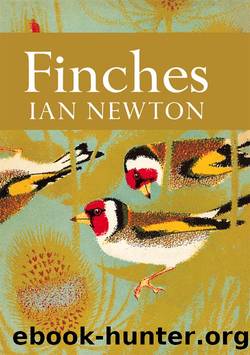Finches (Collins New Naturalist Library, Book 55) by Ian Newton

Author:Ian Newton [Ian Newton ]
Language: eng
Format: epub
ISBN: 9780007406449
Publisher: HarperCollins Publishers
Species Average size of territory* (square metres)
European Goldfinch (Carduelis carduelis) 240
American Goldfinch (Spinus tristis) 250
Lesser Goldfinch (Spinus psaltria) 680
Lawrenceâs Goldfinch (Spinus lawrencei) 310
House Finch (Carpodacus mexicanus) 64
The carduelines clearly hold much smaller territories than the Chaffinch, at most a few hundred square metres, compared with several thousand. To put it another way, about thirty pairs of European Goldfinches could breed simultaneously in the area occupied by the average Chaffinch pair (though they would need other areas in which to feed). Also, while each Goldfinch pair might defend about 240 square metres to begin with, this would decline to less than 12 square metres after the eggs had been laid, which explains why two pairs can sometimes nest together in the same large tree (Conder 1948). I have no idea why, at the time of maximum defence, the territory varies so much in size between species â from 64 to 680 square metres in those studied.
The territories seem to remain intact, even though the cock is absent for much of the time after the eggs have been laid. He continues the defence whenever he visits the nest and, after feeding his mate, he often remains for a time and sings. The territory apparently provides little for the birds except privacy, for most of the food and some of the nest materials are obtained elsewhere. Its functions may be to isolate the pair and enable them to display and mate without disturbance, and to deter other cocks from attempting to court the hen when her mate is absent. The territories also help to space the pairs within a colony so as to lessen the chances of predation on eggs and nestlings.
The grouping of cardueline territories into âloose coloniesâ is not due to lack of nest sites, but to the mutual attraction between individuals. It is true that a small scrub patch in open country might be replete with several finch-species because cover is lacking elsewhere, but even in an expanse of habitat most of the territories are grouped, with vacant spaces left between groups. Goldfinches, Siskins, Serins and Crossbills nest mostly in groups of 2â3 pairs; and Greenfinches, Linnets, Twites and Redpolls in groups of 4â6. In all species, however, larger numbers sometimes nest together, in the Linnet up to 40 pairs within two hectares (five acres). Conversely, in all species some pairs nest in apparent isolation.
The advantages of group-nesting are probably the pooling of information on food sources (see here), and an increased awareness of approaching enemies. Colonially nesting Hawfinches have been seen to join forces to mob a predator, and according to Mountfort (1957), their nesting success is one-third greater than that of Hawfinches nesting alone. Within the colony, as mentioned, the spacing of nests probably reduces further the chance of predation.
Colonies of carduelines change in size and location during the course of the breeding season, partly because some pairs raise their successive broods in different places. This is difficult to detect by ringing, because the same marked pair have to be caught at more than one nest.
Download
This site does not store any files on its server. We only index and link to content provided by other sites. Please contact the content providers to delete copyright contents if any and email us, we'll remove relevant links or contents immediately.
| Amphibians | Animal Behavior & Communication |
| Animal Psychology | Ichthyology |
| Invertebrates | Mammals |
| Ornithology | Primatology |
| Reptiles |
Sapiens: A Brief History of Humankind by Yuval Noah Harari(14210)
The Tidewater Tales by John Barth(12595)
Mastermind: How to Think Like Sherlock Holmes by Maria Konnikova(7195)
Do No Harm Stories of Life, Death and Brain Surgery by Henry Marsh(6875)
The Thirst by Nesbo Jo(6809)
Why We Sleep: Unlocking the Power of Sleep and Dreams by Matthew Walker(6597)
Life 3.0: Being Human in the Age of Artificial Intelligence by Tegmark Max(5447)
Sapiens by Yuval Noah Harari(5281)
The Longevity Diet by Valter Longo(5007)
The Body: A Guide for Occupants by Bill Bryson(4953)
The Rules Do Not Apply by Ariel Levy(4822)
The Immortal Life of Henrietta Lacks by Rebecca Skloot(4502)
Animal Frequency by Melissa Alvarez(4382)
Why We Sleep by Matthew Walker(4342)
The Hacking of the American Mind by Robert H. Lustig(4303)
Yoga Anatomy by Kaminoff Leslie(4289)
All Creatures Great and Small by James Herriot(4213)
Double Down (Diary of a Wimpy Kid Book 11) by Jeff Kinney(4178)
Barron's AP Biology by Goldberg M.S. Deborah T(4081)
